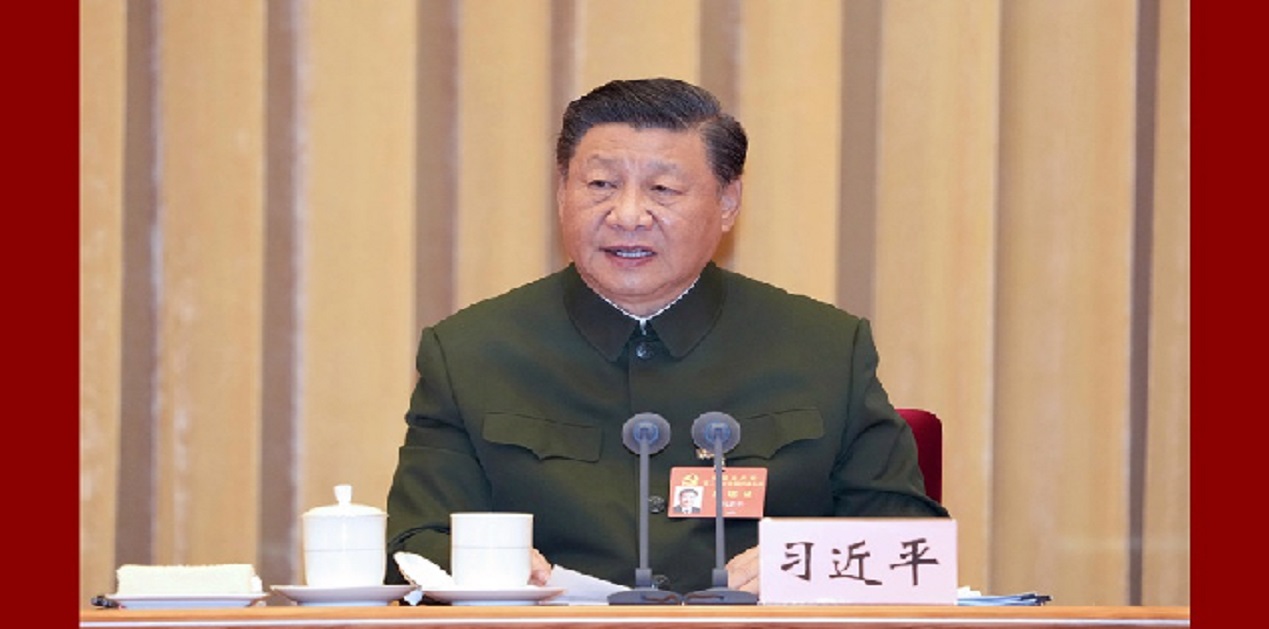The much awaited Chinese 20th National Party Congress (NPC) is behind us, and the National Peoples’ Congress is about four months away. The Work Report by President Xi Jinping has been analysed ad infintum. President Xi Jinping has said that China’s national security is facing increased instability and ordered the People’s Liberation Army (PLA) to devote all its energies to enhancing capability and maintaining combat readiness to fight and win wars.
Consequently President Xi inspected the Joint Operations Command Centre of the Central Military Commission (CMC). In his first address to the PLA post NPC, President Xi said the world is undergoing more profound changes unseen in a century and stressed that China’s national security is facing increased instability and uncertainty, and its military tasks remain arduous. President Xi also set “victory in local wars” as a goal and told the PLA to “improve training and preparation for war in all aspects and improve the ability of the army to fight and win”. The CMC has consequently issued a guideline on the study, publicity and implementation of the guiding principles of the 20th NPC, calling the military for continually aligning the thoughts and actions with them. It highlighted efforts in comprehensively strengthening CPC, stepping up military training and war preparedness in a comprehensive way, and advancing innovation of defence-related science and technology. There is hence the need to study the word and attempt to decipher the prose, in three quintessential posers.
First, what are the larger implications of ‘victory in local wars’? President Xi’s work report cites need to stage military operations readily, create a secure environment, deter and control risks and conflicts and achieve ‘victory in local wars”. It is also stated that PLA must move quicker with troop training and new strategies to reach its target of becoming a world-class military. Pointedly, he said, Beijing would try its best to bring Taiwan back into the fold by peaceful means, but would not renounce the option of using force if need be. Obviously in the assertion that there is only “one China” and that Taiwan is part of it, and to achieve it, use of force was explicit. In that manner the use of military power by PLA was being normalised and clearly intimated.
In fact winning local wars is not new, it was part of PLA’s 1993 Strategic Guidance. However, consequently and more recently, belligerence and aggression has been evident in South and East China Seas, against Taiwan and on the Line of Actual Control in Ladakh in 2020. It is but obvious that contextually ‘local’ can only be these areas. In the same context, ‘war’ herein is obviously force, and not the spoilt avatars of economic war, political war, propaganda war, war on COVID, war on poverty, war on climate change and many, many more!
In the third decade of 21st century, when China has achieved credible national power and international standing, the clarion call of victory against Taiwan seems clear directions to PLA of the end-state of the war. Does this clear and candid threat of use of force have a message for other disputed borders like with Japan and India? While end state and victory can be quantified by use of force in case of Taiwan, the same will not be easily definable across the Line of Actual Control.
Apparently wars by PLA would rest on strong technological scientific foundations in which China has made long strides. Indeed, China’s technological prowess can be greatly disruptive in the battlespace and in the hinterland. The omnipotent question is that will technology only by itself, without conventional force-on-force, lend to define ‘victory’ – in the current contact non-contact/non-kinetic conflagration? Ukraine war has indicated clearly that technological superiority, like in cyber, electronic warfare or space realms, would have advantage in short wars against under-prepared defender; in prolonged wars it will fail to bring rapid decision that portrays victory. It also needs to be understood that Indian nation and militaries have immense resilience and capacities.
Second, does the newly announced line up of the CMC have a message? The six-member military commission has been tailored to continue to achieve one of the China’s national objectives, create the PLA into a world-class fighting force towards 2035/2049 goals, including by putting an emphasis on joint operations.
The appointment of Gen He Weidong as one of the two CMC Vice Chairmen is interesting. It matters that Gen He was the PLA Commander tasked to establish the Western Theatre Command in 2016, and remained at the helm till December 2019, following which he took over the Eastern Theatre Command. The 72-day Doklam border standoff with India in 2017 happened in his time. The planning, preparations and commencement of Exercise in January 2020 in Tibet, which included the latest Type 15 Light Tanks and 155-MM vehicle-mounted howitzer, would have been Gen He’s charter. The formations that participated in the Exercise, having side-stepped from Xinjiang were later poised in Aksai Chin and have been retained in-location consequently. Later as Eastern Theatre Commander, Gen He orchestrated the series of live fire military drills from 04 to 07 August 2022, in six different areas, encircling the island of Taiwan from all directions.
It may not be amiss to analyse that the author of the PLA’s pre-mediated and pre-planned incursions in Eastern Ladakh in 2020, is Gen He, indeed with the express instructions from the Chairman CMC. To sum it, the new Deputy Chairman of the CMC, Gen He Weidong is field experienced on operational plans of Western and Eastern Theatre Commands, and has conducted operations in both Theatres in hostile situations!
In addition to Gen He Weidong, the current top military leaders of Western Theatre Command - the Political Commissar Gen Li Fengbiao and the Theatre Commander Gen Wang Haijiang have joined the very influential 20th Party Central Committee. Gen Li was previously the Commander of the PLASSF also.
Third important poser is to attempt to prognosticate on when next is the PLA’s aggression or expansionist manoeuvres likely? That may be a question worth a billion Yuan and more! US Secretary of State Antony Blinken in October 2022 had warned that China may be working on a “much faster timeline” for ‘dealing’ with Taiwan. It is likely that prior to 21st NPC (2027) President Xi will prove to the CCP and the public at large of the correctness of amending the Constitution to allow beyond two terms as General Secretary. It is also likely by the Centenary of the PLA in 2027, its military modernization would have advanced sufficiently, and compress down timeframes. Gen Xu Xiliang, the outgoing Deputy Chairman of CMC, in a recent and rare article in the People’s Daily has referred to ‘achieving the 100 year goal of building the PLA as scheduled’ and indicated ‘importance of 2027 as a way point towards 2035 and 2049 goals’.
War is not inevitable, but if it comes, it would have world-changing consequences. War may or may not come in our lifetimes, but it cannot be brushed away as passé. When chips are down, the preparations done in peace time only come handy! Even in the next 5-10 years, can China fight a long war, like in Ukraine, which is nine months and going, has had large number of casualties, some limited gains, and eventually may largely lead to a stalemate? Any war will be exceedingly messy, with no clear victor or vanquished! Hence, the CCP and the PLA may continue its attempts at coercion and compellence, using large scale exercises and infrastructural development, creating doubts about Chinese intentions, causing psychological pressures and attempt crisis bargaining of disputed areas with India. These are the games the Chinese regularly play. Hence Chinese may attempt to lead to another crisis, in an attempt to coerce resolution of the ‘LAC problem’ that is too difficult to be solved under normal circumstances!
In sum, while preparing for a conventional war, India must also undertake conflict planning and create flexible response options to counter the menu of China’s coercive options – in which China is a master! We need to consider these options as part of the Chinese escalatory ladder towards war. Seen in this light, China may not be planning an immediate invasion of Taiwan or a conventional war against India. It has to further test the international resolve and response on war initiation. India needs to get on with the strategic, doctrinal and structural reforms in the military. Much opinion has been voiced and written. Even if the reform process is initiated tomorrow, it will take a decade or so to implement. It is inevitable that new apex structures will come; best would be for the military hierarchy to internally decide. For initial focussed planning, three Integrated Theatres (also amalgamating Jammu and Kashmir and Ladakh – Indian Army’s Northern Command), Northern, Western and Southern be created. Let the task at least of contemplation of integrated wars, against respective adversaries and geographies commence. Let the integrated cognition and resilience mechanisms be established. In time and with experience, further finesse can be applied!
(The paper is the author’s individual scholastic articulation. The author certifies that the article/paper is original in content, unpublished and it has not been submitted for publication/web upload elsewhere, and that the facts and figures quoted are duly referenced, as needed, and are believed to be correct). (The paper does not necessarily represent the organisational stance... More >>
Image Source: http://eng.chinamil.com.cn/2022special/attachement/jpg/site2/20221025/1840c96a0d210194741433.jpg











Post new comment